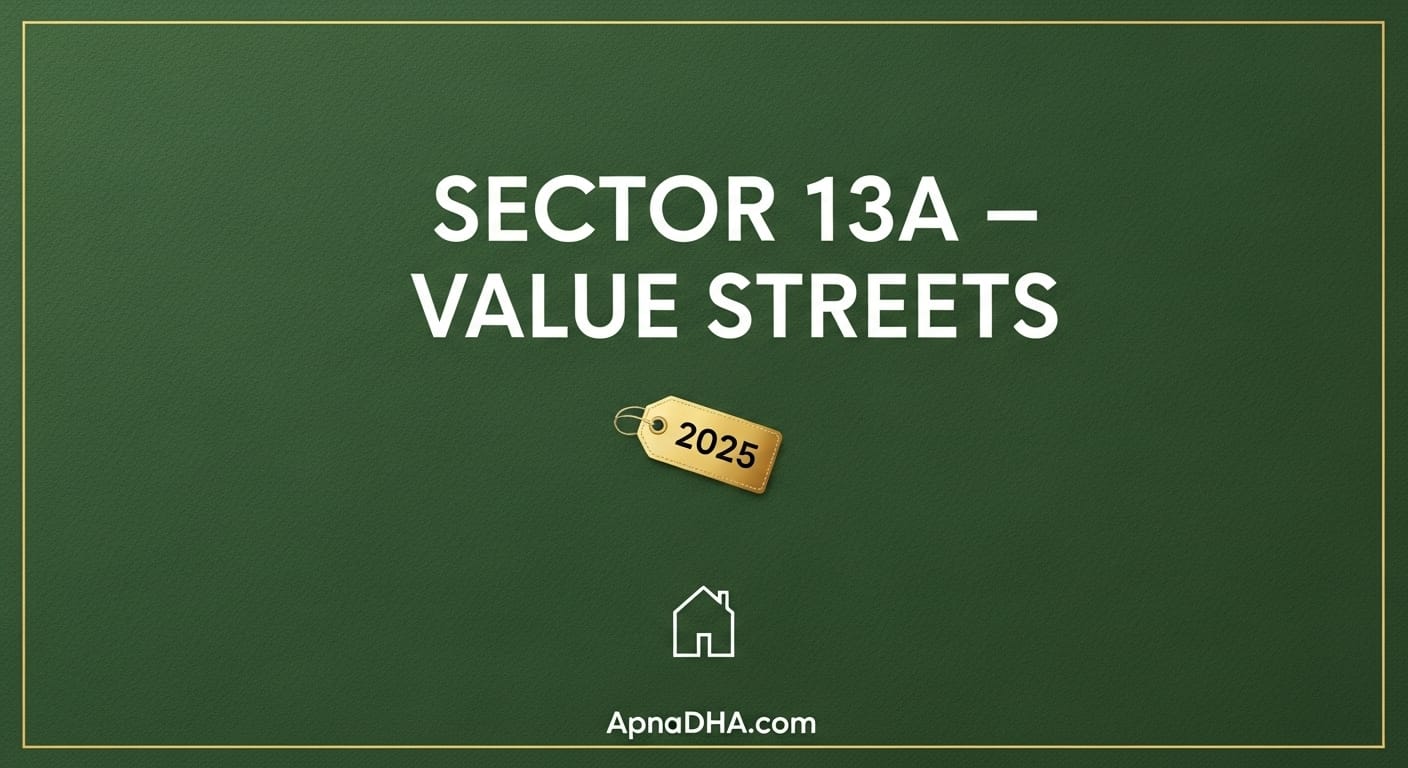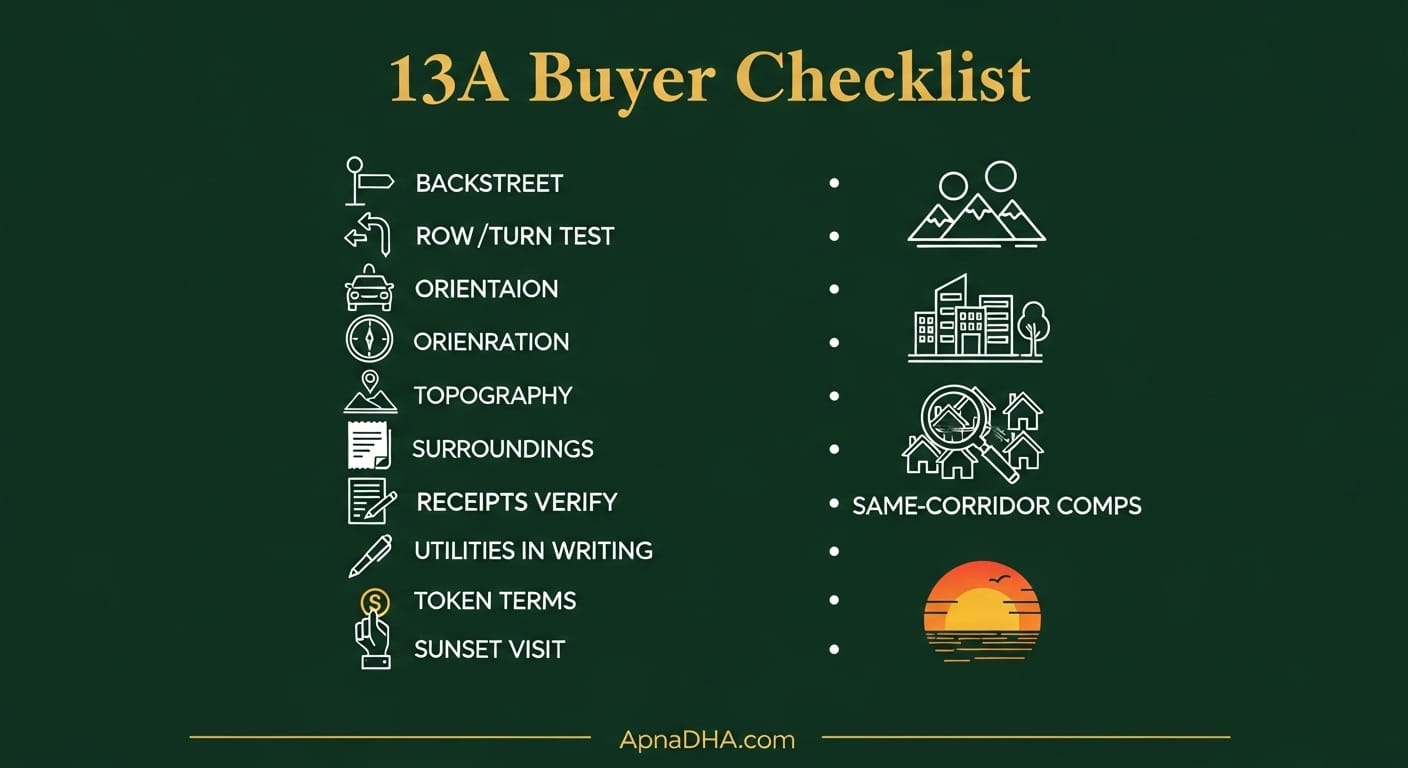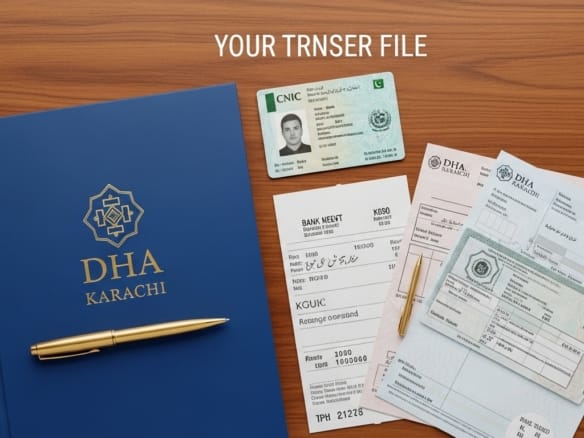
If your brief is simple—“find value without compromising daily livability”—DHA City Karachi Sector 13A | Value Streets & Tips should be on your short list. It’s known for street-by-street opportunities: some pockets feel almost “ready,” others still look mid-transition. That variability is exactly why disciplined buyers win here. Work with micro-location, approach quality, and gradient/topography—and price strictly off same-corridor comps (last 60–90 days). Do that, and 13A turns into a high-signal hunting ground for 200, 300, and 500 yards.
Quick who-it-suits
- End-users seeking 200–300 yds with near-term build plans (but willing to verify utilities/possession in writing).
- Upgraders out of 125/200 who want 300 yds breathing room without the 500-yd jump in carry.
- Investors who understand street selection and negotiation levers (leveling, approach, surroundings).
How Sector 13A “works” (mindset to bring)
Think of 13A as micro-markets separated by short turns and slight level changes. Two streets 200 meters apart can price differently. Your job is to narrow from sector → pocket → street → frontage and keep notes. When the map looks identical, the approach feel, ROW/turning, evening lighting, and neighbor build-load reveal the truth.
Access & movement (practical touring plan)
- Cluster your visits: pick 2–3 adjacent streets per session—avoid zig-zagging across the sector.
- Visit twice: mid-day for heat/traffic realism, sunset for wind, glare, and park-edge behavior.
- Time your turns: a street that’s one extra turn off the main may be quieter, safer, and better for resale.
- Log it: keep a simple note per street—turning radius, ROW comfort, headlight glare, construction noise, cleanliness.
Street-Selection Method (13A edition)
1) Backstreet > Avenue
Avenues look “grand” but often come with noise, glare and cut-through speed. In 13A, one–two turns off the main corridor usually strikes the best balance: access without headache.
2) ROW & turning geometry
Do the SUV three-point-turn test. Record:
- Turning comfort, gate swing vs sliding feasibility
- Porch depth (1 big SUV or 1 SUV + 1 compact?)
- Corner radii and cul-de-sac mouths (bonus or bottleneck?)
3) Orientation & premiums (priced inside the same street)
- West-open: catches breeze—counter heat with shading, glazing specs, and landscape.
- Corner: extra light/parking—watch for cut-through traffic.
- Park-facing: lifestyle/resale appeal—check evening parking pressure, kids’ play, and headlight glare.
Pay any premium only after comparing within the same street hierarchy—not across the sector.
4) Topography & drainage (your quiet superpower)
Stand at the lowest corner after a wash/rain; trace the water path. If the plot needs fill/compaction, quantify it and fold into price. Gentle slope away from your porch is comfort; ponding near your boundary is leverage.
5) Surroundings & “pocket finish”
Look for paved edges, signage, working streetlights, cleanliness, vigilance presence. Count active builds—dust/noise horizons matter if you plan to live or rent soon.
6) Utilities & possession (in writing)
Verbal promises don’t count. Ask for dated letters/emails on utilities/possession. Photograph documents; keep duplicates. Verification protects your token and your exit.

What sizes make sense in 13A (and how to plan)
200 yards (liquid & liveable)
- Why: largest buyer pool; simpler construction budgets; quick to rent or resell when papers/utility status are clean.
- Plan ideas: porch (1 car), drawing/powder up front, open kitchen + family lounge, 1 ground-floor bed; upstairs 3 beds + terrace.
- Design notes: deeper overhangs, cross-vent windows; pre-run conduits for solar/inverter + EV.
300 yards (move-up comfort)
- Why: better frontage + parking geometry; real study/home office; flexible family zoning.
- Plan ideas: 2-car comfort (or 1 SUV + 1 compact), show + service kitchen option, guest suite ground, shaded terrace above.
- Design notes: keep shafts stacked; align stair core to accept a compact lift later.
500 yards (select pockets)
- Why: villa-grade footprint with elevation presence. Best when pocket feels “ready” or clearly trending.
- Plan ideas: formal suite + family core, show + service kitchen, optional gym/office; basement only after soil/water-table investigation.
- Design notes: service circulation (staff/utility) separate from formal areas; acoustic/thermal comfort first, façade drama later.
Pricing Discipline (avoid the nudge)
- Same-corridor comps (60–90 days)
Demand 3–5 trades from the exact corridor—not a sector average. Adjust for your plot’s specifics (corner/park/west-open, cul-de-sac mouth, transformer adjacency, boundary clarity). - Ready vs developing pockets
Ready pockets deserve higher asks but de-risk your timeline. Developing pockets must pay you for time risk (carry, uncertainty, admin friction). Discount accordingly. - Full-paid vs dues-remaining
Compute the true total: remaining dues + any penalties + your time value + number of admin trips. A “cheap” ask isn’t cheap if the carry eats your saving. - Leveling & approach math
Quantify fill/compaction, curb cuts, and porch/gate adjustments. These are credible negotiation levers—especially in value streets. - Evening reality check
If park-edge glow blinds your porch or cut-through rush peaks at sunset, price that pain or walk away.
Negotiation Levers That Actually Work in 13A
- Fill/compaction requirement (quote from contractor = price chip).
- Approach quality (one extra turn off a busy spine = quieter living; use it to explain your offer).
- Neighbor build-load (months of dust/noise ahead? discount or escrow for cleaning/mitigation).
- Boundary clarity & pegs (map extract + pegs marked = confidence; mismatch = reason to revise).
- Receipts & acknowledgements (anything unclear on verification? pause token or renegotiate).
Installments & payment hygiene (simple rules)
- Prefer published/recognized plans where available; always pay through official rails so acknowledgements show up in verification.
- For ready pockets, full-paid or clean dues-remaining is usually simpler—especially if you want to break ground soon.
- Private “installment” pitches are fine to hear, but normalize against a recognized table (down-payment %, cadence, total ticket) and keep proof flows verifiable.
Build-Now vs Hold-Then-Build (which path wins here?)
- Build-now suits ready or nearly ready pockets; you lock value via livability and get ahead of later price steps.
- Hold-then-build suits buyers with a patient horizon who secure a real discount in developing pockets—document utility timelines and carry cost assumptions.
Sector 13A Buyer Checklist (print this)
- Backstreet selection: one–two turns off main; avoid avenue glare/noise.
- ROW & turning: SUV three-point-turn test; gate swing vs sliding; porch depth notes.
- Orientation pricing (same street only): west-open breeze; corner light/parking; park-facing lifestyle (check evening pressure/headlights).
- Topography: lowest-corner water path; list fill/compaction/retaining cost.
- Frontage & massing: façade options, car maneuver, privacy from opposite homes.
- Surroundings finish: paving, signage, lighting, cleanliness, vigilance presence.
- Under-construction load: count active builds; dust/noise horizon matters.
- Paper chain: allotment/transfer history + seller CNIC copies.
- Receipts & dues: verify payments/acknowledgements on official portals before token (screenshots ≠ documents).
- Utilities & possession: insist on written status/timelines (letters/emails).
- Same-corridor comps (60–90 days): collect 3–5 with dates and reference details.
- Token terms: refund triggers, cheque numbers, transfer window, who pays which fees—all in writing.
- Photos & video: porch/approach, lowest corner, manholes, lighting poles, neighbor activity.
- Second visit: walk at sunset to feel wind, traffic, glare, parking behavior.
Ten Common Mistakes in DHA City Karachi Sector 13A (and how to avoid them)
- Cross-sector pricing—every corridor trades differently; price inside your street.
- Avenue-front impulse—prestige now, noise forever.
- Paying park premium blindly—evenings can flip the equation (parking pressure, glare).
- Ignoring slope—water finds the lowest boundary; you’ll pay later if you don’t price it now.
- Tokening on screenshots—verify on the official portal first.
- Under-speccing MEP—thermal/acoustic comfort > façade drama for real daily value.
- Skipping utilities in writing—verbal “soon” is not a milestone.
- No porch/gate geometry check—daily usability (and resale impressions) start at the curb.
- Forgetting service circulation—laundry/utility/refuse lines must not cross formal areas.
- Single visit—sunset reality (breeze, glare, traffic) is different; always do two.
FAQs
Q1. Is Sector 13A good for end-use or investment?
Both. End-users pick 200–300 yds for build-now; investors find value by pricing street-level and quantifying fill/approach/finish.
Q2. Park-facing vs corner vs west-open—what’s best in 13A?
Depends on your street and lifestyle. Price any premium within the same street and only after a sunset check for parking pressure and glare.
Q3. Ready pocket or developing pocket?
Ready pockets cost more but reduce time/utility uncertainty. Developing pockets can be value if they compensate for carry and you have written timelines.
Q4. How do I verify dues/payments before token?
Use the official verification flows so acknowledgements match CNIC/Membership/File info. Screenshots aren’t documents.
Q5. Basement on 13A plots—yes or no?
Case-by-case. Always get a soil investigation and consider water-table/retaining. If not basement, a media/den or sunken lounge can deliver similar vibe with less risk.
Internal Links
- Sectors Hub: /dha-city/sectors
- Neighbor sectors: /dha-city/sector-6 • /dha-city/sector-11e • /dha-city/sector-14a
- Sizes referenced: /dha-city/plots-200-yards • /dha-city/plots-300-yards • /dha-city/plots-500-yards
- Market & paperwork: /dha-city/prices-latest • /dha-city/payment-plans • /dha-city/transfer-fee-process
Conversion Blocks (place near top, middle & end)
ApnaDHA — DHA City Desk
Share budget + preferred streets, and we’ll WhatsApp today’s five best paper-verified 13A options—often with short walk-through videos.






Join The Discussion